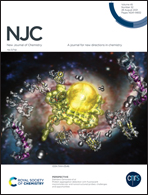Enhancement of visible light driven dye degradation and photocatalytic H2 evolution over MoS2 through combination with perylene diimide aggregates†
Abstract
Exploiting an efficient and cheap catalyst for the elimination of organic contaminants from wastewater and photocatalytic hydrogen evolution has drawn great attention recently. Herein, MoS2 nanoflowers (MoS2 NFs) and 1-phenol-perylene diimide microbelts (PPDI MBs) were prepared by a hydrothermal and solvent exchange process, respectively. They were closely mixed by a hydrothermal method to obtain novel organic–inorganic MoS2/PPDI p–n heterojunction photocatalysts (MoS2/PPDI HSs). Remarkably, the optimized MoS2/PPDI HS catalyst exhibited high-efficient photocatalytic activity for Methyl Orange (MO), Methylene Blue (MB), and Eriochrome Black T (EBT). Meanwhile, the new composite showed better hydrogen evolution reaction activity. The significant enhancement of photocatalytic activity is due to the formation of a Z-scheme p–n heterojunction and large specific surface area, which can effectively separate and transfer interfacial charge. The radical scavenging techniques confirmed that superoxide radical anions (˙O2−) and holes (h+) played important roles in the photocatalytic process. This study suggests that the novel composite material has a broad application in solving environmental and energy problems due to the simple and cheap synthesis process, low raw material cost and environmentally friendly methods.



 Please wait while we load your content...
Please wait while we load your content...